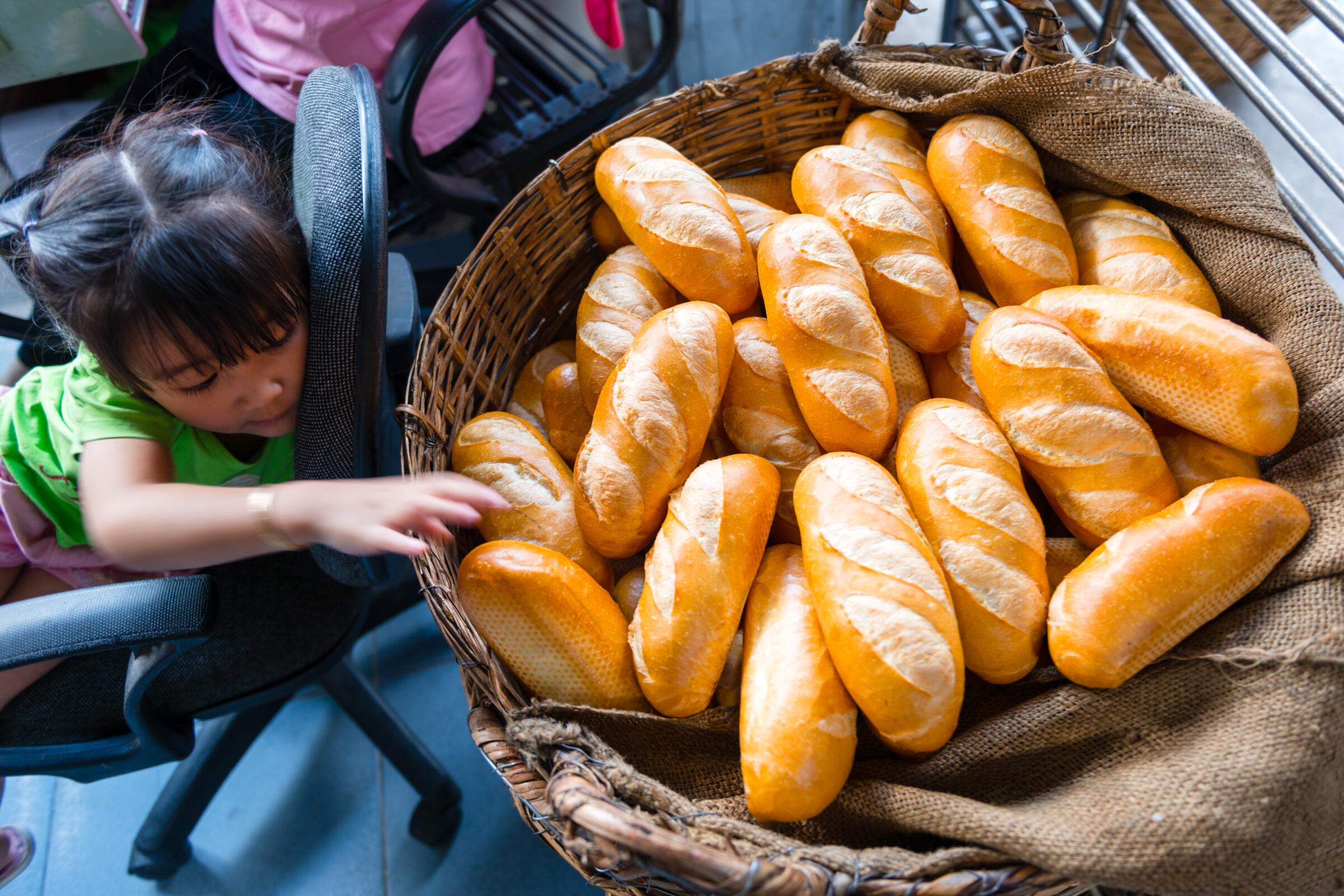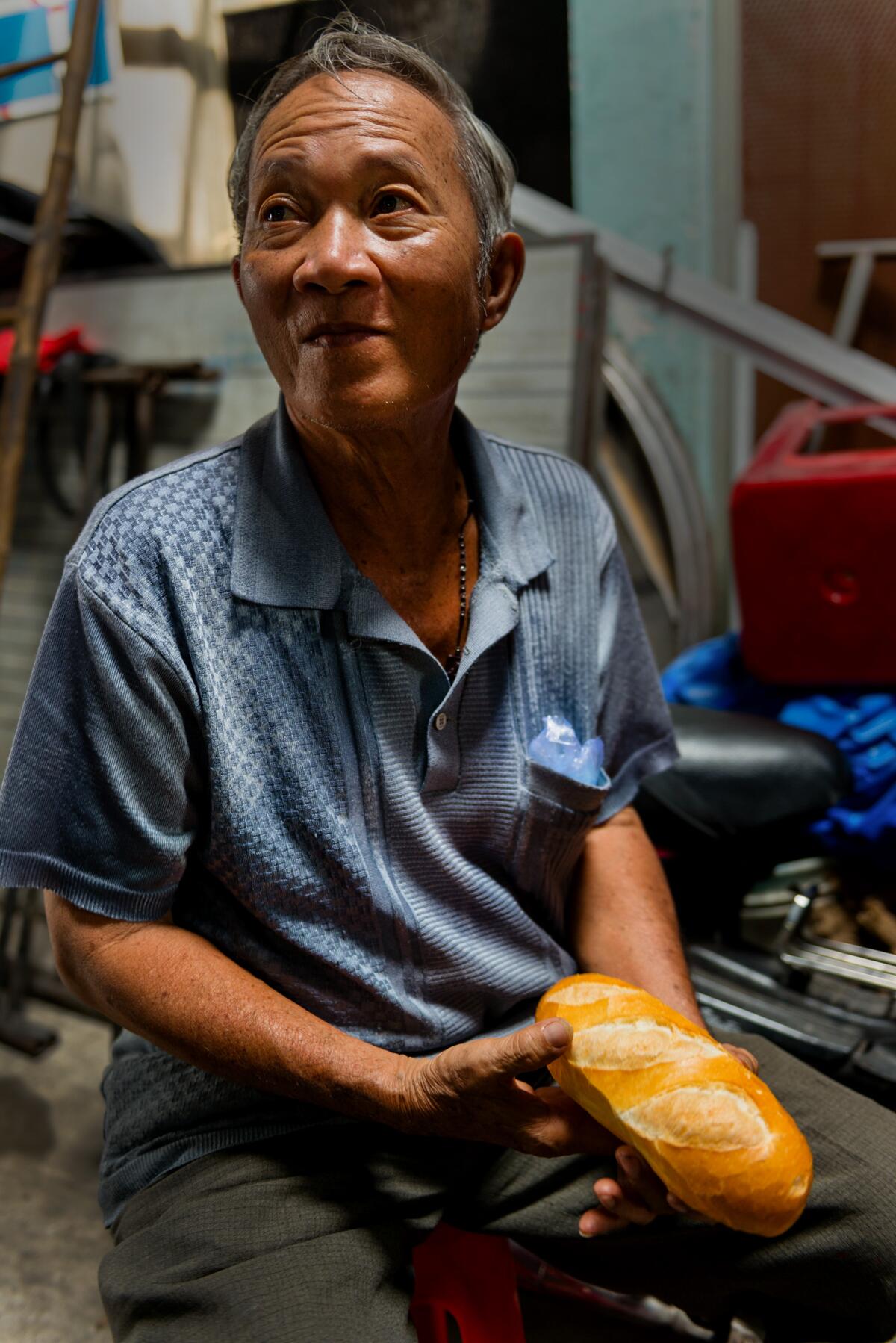Newsletter
Eat your way across L.A.
Get our weekly Tasting Notes newsletter for reviews, news and more.
You may occasionally receive promotional content from the Los Angeles Times.

Dung Ho, the third-generation owner of Bay Ho, a banh mi stall in Ho Chi Minh City, Vietnam, held the chubby loaf of bread to my ear, rotary-phone receiver style, and pinched it.
“Can you hear it?” he asked. Indeed I could: a satisfyingly crunchy shatter that I would come to learn is the most desirable of attributes for a Saigon-style banh mi bread.
A zillion articles have been written about banh mi, Vietnam’s justifiably beloved and famous sandwich. But much of what has been said about the bread element of the dish isn’t exactly glowing praise. Mocked as low-quality, accused of being a baguette impostor, exoticized by spurious claims of rice flour, banh mi bread suffers from bad press.
Yet I knew firsthand that cooks, chefs and bakers outside of Vietnam have struggled to re-create this very specific carb. Surely banh mi bread is more than just a knockoff baguette, I thought, and to find out what makes it unique, I went to the source.
Known colloquially as Saigon, Ho Chi Minh City is banh mi country. The sandwich most likely got its start in the north or center of Vietnam, a union of the bread and charcuterie of French colonizers and the seasonings and sensibilities of Vietnamese and Chinese inhabitants, but today, this southern city virtually runs on banh mi.
“Like any big city, we have a lot of hungry people,” said Peter Cuong Franklin, a Vietnam-born, U.S.-raised chef. “They don’t have time to sit down. Banh mi is like energy bars! You can hold it, walk around, take it back to the office.”

I was talking to Franklin in Anan Saigon, his flagship Ho Chi Minh City restaurant that grabbed headlines in 2017 when it offered an off-menu, truffle-and-foie-gras-stuffed $100 banh mi — and people bought it. I had asked the chef for his thoughts on banh mi bread, and he presented me with a tray topped with two loaves: the light, blimpy Saigon version and, at nearly half its size, the denser Hanoi-style.
“There’s no perfect banh mi bread,” he said, clutching a balloon-like loaf in one hand and a glass of wine in the other. “The classic Hanoi-style banh mi bread is chewy, heavy — closer to a French baguette. But in the south and Ho Chi Minh City, everything is bigger.”
Franklin went on to explain the inherent paradox of Saigon-style banh mi: It’s a dish that aspires to excess but that stubbornly remains working-class. This has resulted in sandwiches revolving around increasingly large loaves designed to accommodate as many as six kinds of Vietnamese cold cuts, a smear of pâté, a salad of pickled daikon, carrots, chile, green onion and cilantro, and a larder of condiments, while still carrying a low price tag (a typical banh mi in Ho Chi Minh City costs around 17,000 dong, or about 73 cents). As most Vietnamese immigrants came from the country’s south, it’s this style of banh mi that those of us outside Vietnam are familiar with.
“People think,” Franklin told me, paraphrasing Saigoners, “‘if we can make it bigger, we’re gonna do it!’ It’s like the sandwich at Katz’s Deli.”

A week before meeting Franklin, I was in a dusty, humid bakery just south of central Ho Chi Minh City. Two men, cigarettes rarely absent from their lips, were making Saigon-style banh mi loaves (the more I learned about this particular style of bread, the more reluctant I became to use the term “baguette” to describe it).
A dough was formed in an industrial mixer, divided into portions, lubricated with oil, given a brief knead that was less about forming gluten and more about shaping the loaves, and set aside to rise. After three hours at Saigon room temperature, the loaves were sprayed with water, given three slits with a homemade tool that combined a bamboo stick and a Bic razor blade, and baked at 500 degrees for 16 minutes. When the bread emerged from the oven, it emitted a distinct snap, crackle and pop, and in an instant, the previously smooth loaves had gained their requisite cracked eggshell exterior.

From a Western baking standpoint, all of this was insanity. The dough was almost impossibly wet; the mixer, seemingly set to 11, was essentially whipping the dough; there was no rise before shaping the loaves; the amount of oil involved was not inconsequential; the cooking time was crazy short and the oven temperature bonkers high. Yet modern advances in baking — in particular high-protein flours, so-called dough improvers and other additives, as well as hardware such as electric, steam-injecting, rotating convection ovens — have given Vietnamese bakers the ability to turn tiny knots of dough into disproportionately puffy loaves.
“The banh mi I used to make was the best,” explained 71-year-old bakery owner Van No Nguyen, who has been baking for 40 years. “It was denser, heartier.”
He went on to tell me that, only a decade ago, he relied on just a few basic ingredients — yeast, flour, water, salt — and baked his bread in coal ovens, but that there are few, if any, who still do this in Ho Chi Minh City.
I asked Nguyen if his dough included rice flour — an oft-repeated claim in the West, thought to be the secret to the bread’s cottony crumb and thin, crispy crust — and he appeared confused.
“After the war, we used eggs instead of yeast,” he offered. “And there was a time when we had to move away from really nice wheat and I had to lighten the dough with other starches, such as tapioca flour.”

But neither in Nguyen’s bakery nor at any of the others I visited had anybody even heard of using rice flour — a gluten-free starch that would inevitably turn dough into bricks when baked.
There’s undoubtedly a financial motivation to this style of baking — more, faster, cheaper — but each step in the process also contributes to the creation of a very specific loaf of bread, one that serves a very specific purpose.
“Banh mi bread should be big, so it can hold many ingredients,” said Hoa Tu, the owner of Banh Mi Hong Hoa, a combination bakery and banh mi stall in Ho Chi Minh City’s District 1. The sandwiches at her family’s stall were indeed large, but not as gut-busting as others I’d encountered, and had a near ideal balance of protein, condiments and crunch from both the bread and vegetables. (Along these lines, Peter Cuong Franklin, a Yale alumnus and former investment banker, shared with me his personal “210 Rule” for banh mi: the perfect sandwich, he believes, has 70 grams of bread, 70 grams of meat and 70 grams of vegetables and seasonings). Indeed, there was a cohesiveness to the sandwich at Hong Hoa that made me not even really notice the bread — nor any other particular element — which, I think, is precisely the idea.
“It’s different from bread from foreign countries,” explained Dung Ho, the man who taught me the concept of listening to my banh mi. “That bread is too heavy with too much flour; people get too full from eating it.”
More killer, less filler, in other words. Isn’t this what we all want in a sandwich?
Eat your way across L.A.
Get our weekly Tasting Notes newsletter for reviews, news and more.
You may occasionally receive promotional content from the Los Angeles Times.